A Night Among Snowy Peaks, Stars, and Constellations
You have a date with ancient Andean civilizations: it’s time to spend the night at our exclusive Sky Camp, nestled among sacred snowy peaks under the starry sky and constellations of the Peruvian Andes. Who hasn’t dreamed of this experience? After exploring many attractions in Cusco, we’re sure your greatest wish is to be part of this adventure. Are you ready?
In the Andes, there’s a unique way to view the sky. In this blog, we’ll explore the infinite Andean night sky, the same sky you’ll encounter on the magical night between the Salkantay and Humantay snowy peaks. This is the perfect place to view stars and Andean constellations with unique clarity, thanks to the lack of light pollution and atmospheric contamination. You’ll be inside your glass dome, lying on your bed, feeling like the Milky Way is within your reach. Depending on the time of year, you might also see formations like the Southern Cross and Orion. Only some days offer such an opportunity, right? Imagine sleeping in a luxury glamping site amid the snowy Andean mountains.
Now, let us tell you a bit about the history and curiosities surrounding this fascinating world of Inca astronomy. We’ll also describe the Sky Camp, how it came to be, and how you can be part of this adventure under the stars. One fun fact: Did you know the Milky Way and its shadows closely relate to Inca history?
- What is the Sky Camp?
- How Can I Be Part of This Glamping Experience?
- What Are Constellations?
- Astronomy’s Connection with Inca Religion
- The Relationship of Constellations to Cusco’s Urbanization
- The Inca Calendar
- The Intihuatana of Machu Picchu
- Inca Astronomical Observatories
- What is the relationship between Inca astronomy and agriculture?
- You may be interested in:
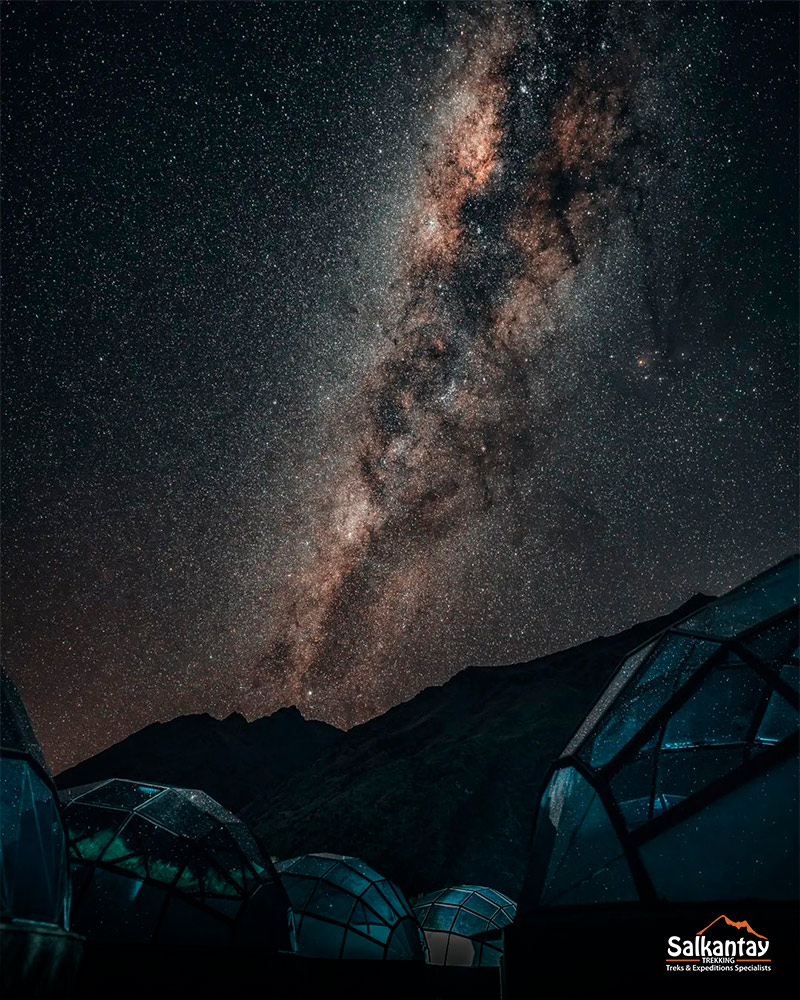
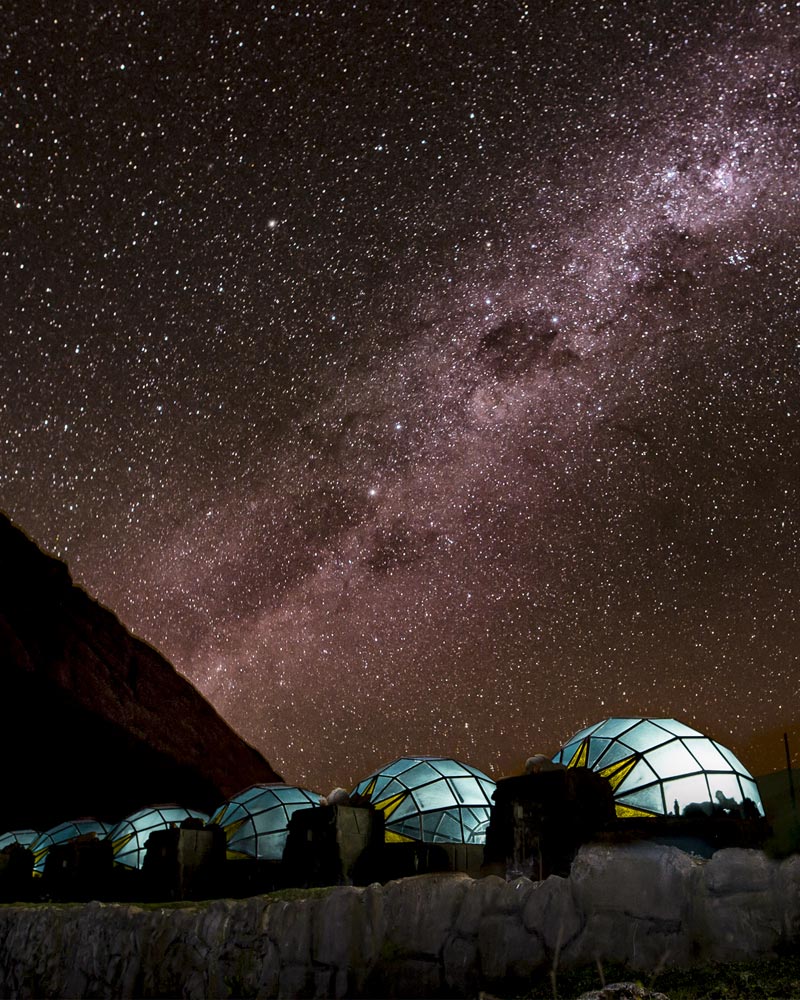
What is the Sky Camp?
Sky Camp is the most daring and innovative project in Latin America, located in Soraypampa. It started in 2016 as a “stargazing glamping” concept, the best Andean experience among the imposing Salkantay and Humantay peaks near the famous Peruvian Andes lake, Laguna Humantay.
The accommodations consist of glass-domed structures that provide a 360-degree panoramic view of the starry sky, adorned with traditional Peruvian entrances and beautiful landscaping. It includes hotel-like facilities, with bathrooms and dining areas in the same glass dome style, ensuring meals with the most stunning views of the snowy mountains.
Delicious Food
Enjoy an exclusive menu, renowned and crafted by highly skilled chefs specializing in some of the most flavorful and creative dishes prepared amidst the snowy peaks of the Peruvian Andes.
How Can I Be Part of This Glamping Experience?
Salkantay Trekking, the exclusive tour agency and operator, offers numerous options for you to enjoy this experience, with all its luxury, as part of fabulous and unforgettable treks.
There’s a wide range of routes to choose from, from a one-day tour (round-trip) for visitors with limited time to more elaborate tours like the Humantay Lake and Salkantay Trek of 2 days and 1 night, the Short Salkantay Trek to Machu Picchu of 4 days and 3 nights, the Classic Salkantay Trek to Machu Picchu of 5 days and 4 nights, and even more comprehensive experiences of 7 days and 6 nights on the Salkantay Trek and the Classic Inca Trail to Machu Picchu.
On multi-day treks, you’ll also have the chance to stay at other glamping sites provided by Salkantay Trekking. Discover all our packages on our website: Salkantay Trekking.


What Are Constellations?
Constellations are patterns formed by observed movements in the sky, connecting stars like a game of connecting dots. For reference, they were named constellations.
Astronomy is one of the oldest sciences. The Incas managed to understand celestial movement patterns, identify moon phases, predict lunar and solar eclipses, define planetary movement constants, and associate sky events with Earth’s phenomena.

Constellations in Inca Culture
For the Incas, earthly and celestial phenomena were connected to gods. Thus, many of the figures observed in the sky represented deities. Often, the sky was used to tell stories of a complex mythology passed down through generations. In addition to gods, various living beings and objects were represented in constellations.
Constellations Today
In the 20th century, the need arose to create a universal system of constellations so that all people could recognize the sky similarly. With the advancement of studies on celestial bodies, the necessity of standardizing the organization of stars became clear, allowing everyone to locate an object in the sky or find order in the universe using the same reference constellation.
Thus, in 1929, the International Astronomical Union (IAU) divided the sky into 88 regions, each identified by a drawing. Unlike certain astronomical cultures, a star cannot belong to more than one constellation in this division, as this would prevent an exact division of the sky. It was also established that a constellation is not just the drawing itself but that the sky is divided by imaginary lines, with the drawing used to identify each region in the sky. This means that even if a star does not form part of the drawing, it still belongs to the constellation.
Today, we understand that constellations are not natural objects but patterns formed by stars in the sky as seen from Earth. We also know that stars we observe as close together, forming a shape, are often highly distant from each other and are not connected in any way. Today, we also understand that constellations change shape depending on the region of Earth from which they are observed, meaning they are not the same everywhere in the world.
The Dark Constellations of the Incas
We will explore how this advanced and intelligent civilization managed to decode the sky and the Milky Way, discovering animals in dark regions and creating constellations. As the dark regions of the Milky Way are more visible and impressive in the Southern Hemisphere, constellations stand out so much on clear nights at Sky Camp that the central region of the Milky Way can cast shadows on the ground.
In South America, the Incas developed advanced and fundamental astronomical knowledge. They studied the sky in detail, identifying not only bright constellations but also the dark constellations of the Milky Way. They believed that Viracocha, the supreme god of creation, had assigned each animal or living being a star to protect it.
By observing the stars, the Incas recognized the images of various animals walking along the Willka Mayu (Milky Way). They discovered that their primary function was to indicate the different stages of the agricultural cycle. These animals were intriguingly found in the dark areas of the Milky Way.
They also identified two types of constellations: the first formed by thousands of stars that, together, create images of gods and animals; the second, formed by animated constellations, corresponded to the dark spots of the Milky Way.
For the Incas, the sky and Earth were connected. The Milky Way itself was considered an immense astral river. Another interesting fact is that the Incas viewed the Vilcanota River, which crosses the Sacred Valley, as a reflection of the Milky Way.
Among the constellations identified by the Incas, the following stand out:
Yutu Lluthu (Partridge):
The partridge is a small bird that vaguely resembles a hen. Yutu Lluthu, however, has gray-brown plumage. This dark constellation (known in Western astronomy as the Coal Sack) appears in the sky at dawn in October. It remains visible until July, when the harvest of various root vegetables in the Cusco region ends. It is also associated with the end of the dry season and the arrival of the first rains of the agricultural cycle.
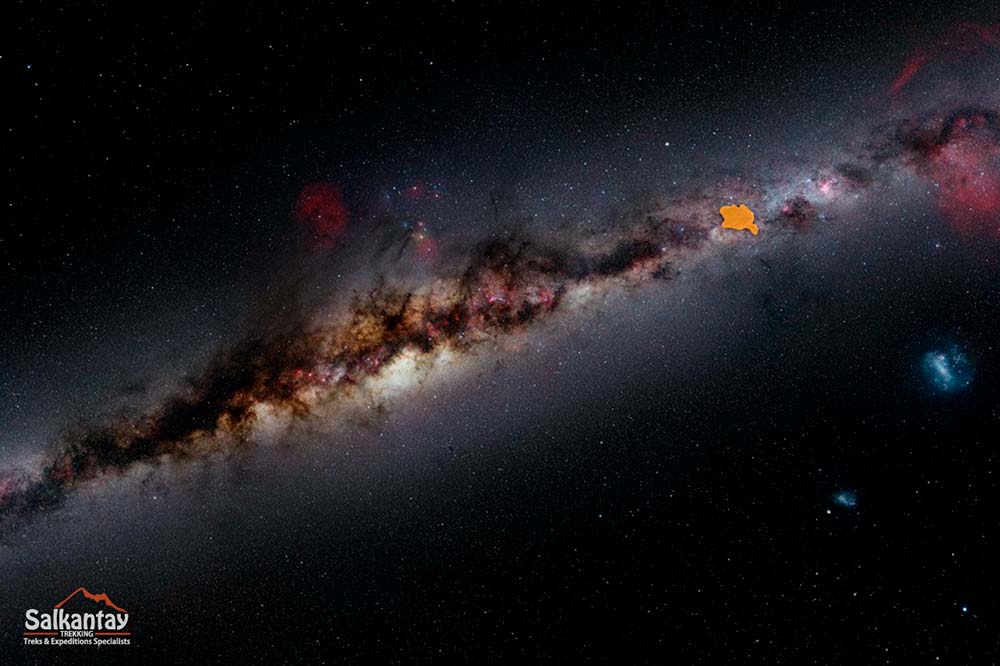
Hamp’atu (Frog):
In Andean culture, the frog symbolizes water and natural springs. It’s said to be a beloved animal of Pachamama (Mother Earth) as it shelters her during hibernation. Additionally, this animal assists field workers when plants sprout, protecting them from predators. The dark constellation of the frog appears in the sky at dawn in late October, with the croaking of frogs announcing the first rains.
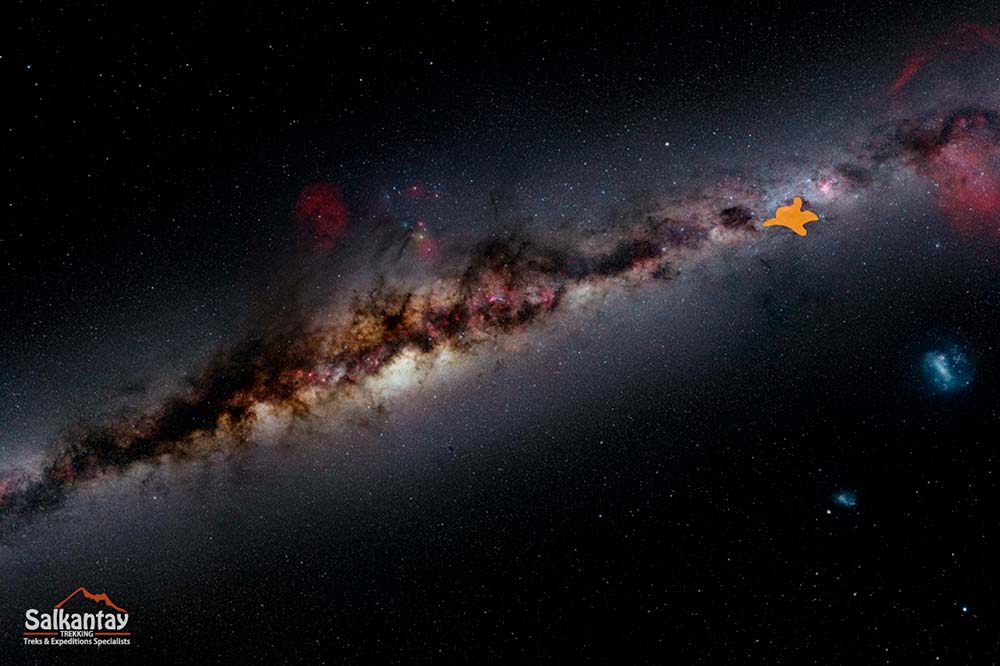
Mach’aqway acuay (Serpent):
Serpents are significant in Inca astronomy as they represent Ukhu Pacha, the underworld. They are also closely related to water and the agricultural cycle. While frogs and serpents have positive connotations in Andean culture, the serpent took on negative associations with the arrival of Western culture. The head of the serpent constellation appears in August and disappears in February, a period when serpents are most active in the Andean region. Frogs, partridges, and serpents are animals that aid Andean agriculture by controlling various pests.
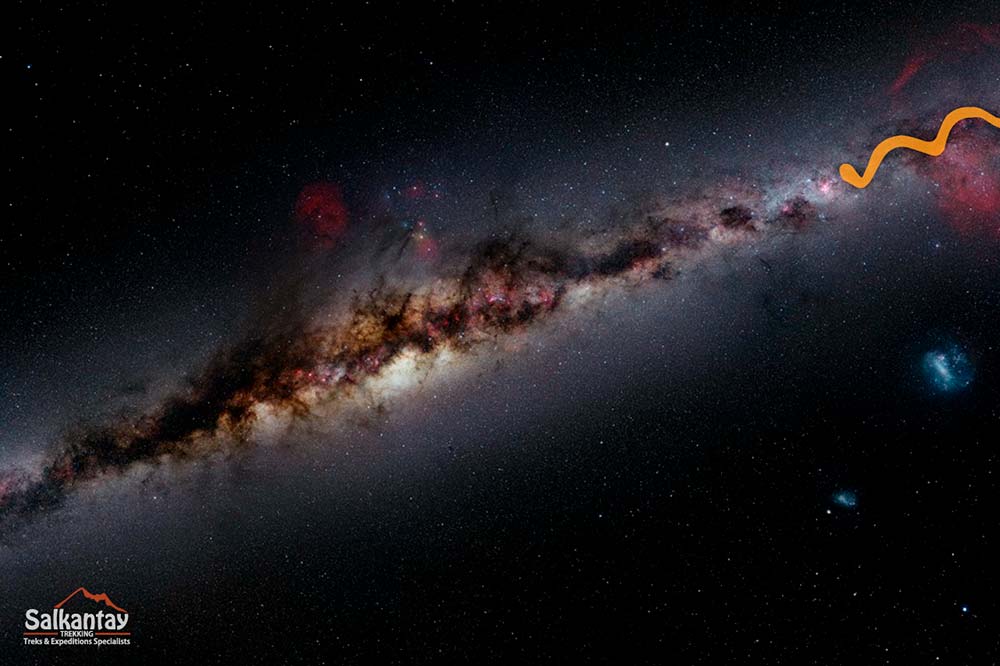
Yana llama (Black Llama):
The giant black llama is the biggest and perhaps most crucial dark constellation. It’s recognized in the sky by its eyes—two bright stars, Alpha and Beta Centauri, near the Southern Cross. This dark constellation comprises the figures of a mother llama and her offspring. It appears in the sky in November and represents a legend in which a tremendous black llama descends to earth to drink from all the springs and rivers of the world and the ocean to prevent the world from flooding.

Atoq (Fox):
The fox is one of the most striking and peculiar constellations in the Andean sky due to its deep red eyes. Some say it is near the young llama to devour it, while others believe it flees from the constellation of the Shepherd, who protects the llamas. The fox is located near the stars, forming the tail of the Western constellation of Scorpio. It’s an ambivalent character in Andean stories and is associated with harvests.
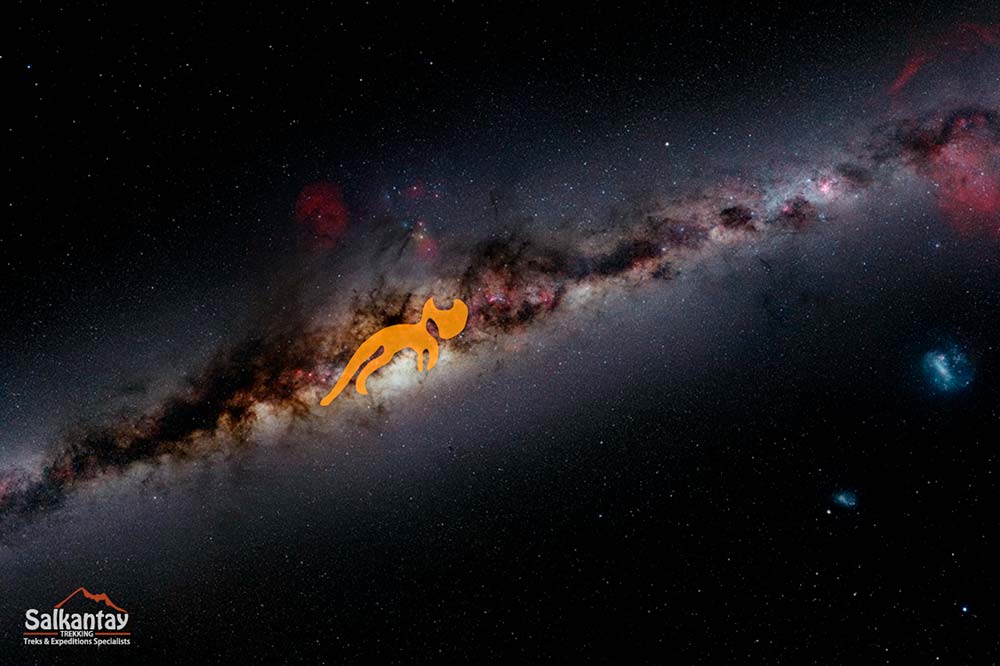
Michiq (Shepherd):
The Shepherd is said to watch over the cosmic llamas, protecting them from any threat, and its form resembles a person with arms spread wide as if scaring off the fox.
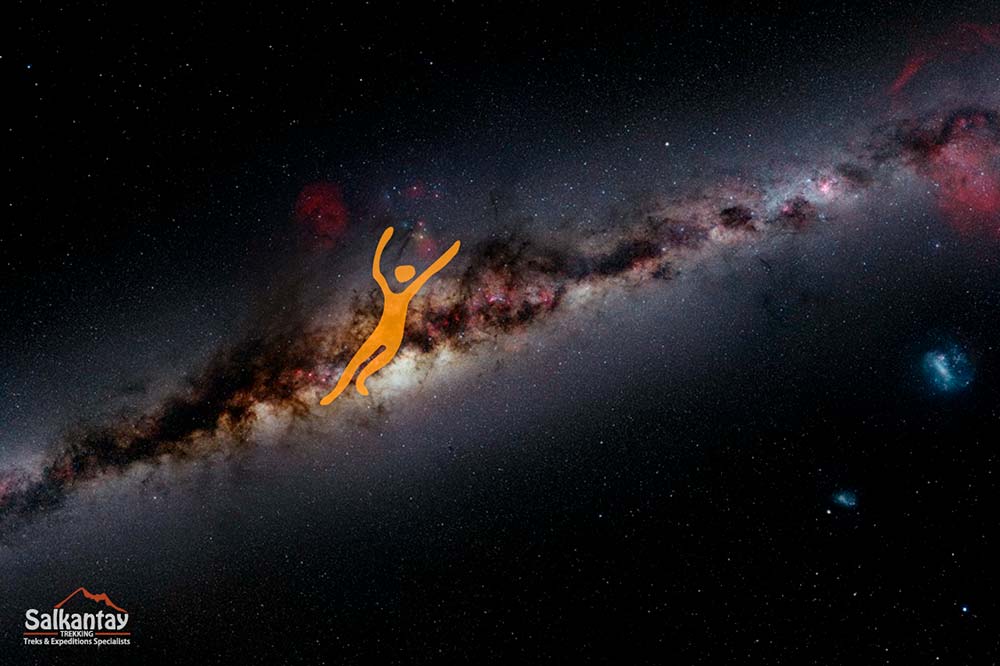
Chakana (Southern Cross):
Discovered by the Incas, the Southern Cross is one of the most iconic constellations of the Southern Hemisphere. Its distinctive shape makes it easy to locate and can be seen almost year-round.
Astronomy’s Connection with Inca Religion
The Inca religion was fundamentally based on astrology. According to Inca belief, every element on earth had its counterpart in the Milky Way, and the sky served as a foundation for worshiping their gods (Hanan Pacha). Hence, the Inca religion was deeply linked to the stars.
In the sacred temple of Qoricancha in Cusco, they worshiped the sun god, Inti, in Quechua, as well as the moon (Qilla), the stars (chakras), and lightning (Illapa), their gods associated with solstices, equinoxes, and seasonal changes, essential for sowing and harvesting periods.
The Relationship of Constellations to Cusco’s Urbanization
During the Inca Empire, Andean constellations influenced the city’s urban layout. Cusco, when viewed from above, resembles the shape of a puma, with the fortress of Sacsayhuamán as its head, the Plaza de Armas as its heart, and the Qoricancha temple as its tail.
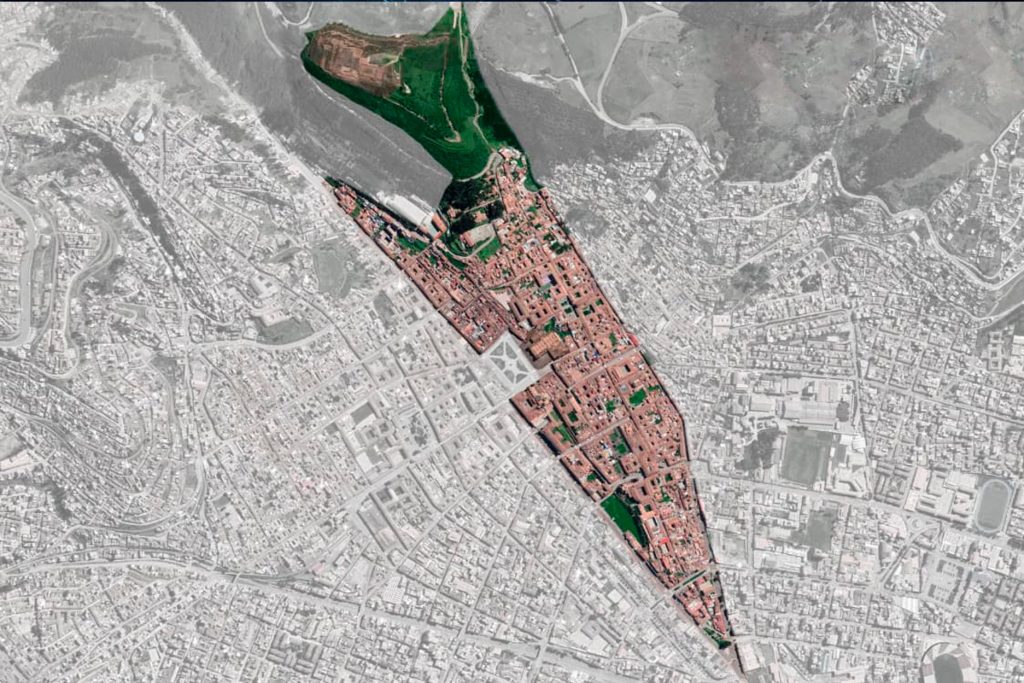
The Inca Calendar
The Inca calendar was a time-measuring system based on the sun and moon, consisting of 365 days and 12 months, designed by the rulers of the Inca Empire to mark their religious and agricultural festivals. Originating in Cusco, the year was divided into 12 periods, each lasting 30 days.
According to scholars, the last day of each period was dedicated to market and product exchange (known as “what”), and each month included a festival related to the harvests. The Inca calendar was essentially lunisolar, closely tied to astronomy.
There were two parallel calendars—one solar and one lunar. Inca astronomers understood the equinoxes and solstices, though they could not predict eclipses. Each region of the empire determined its date to start the year. Cusco, for example, chose August to begin the year, aligning with the start of planting season in the region.
The Intihuatana of Machu Picchu
The Intihuatana was constructed during the reign of Emperor Pachacútec in the 15th century, at the height of the Inca Empire. It is a stone structure in the shape of a polygon, approximately 1 meter tall and 2 meters in diameter, located in the citadel of Machu Picchu. Intihuatana is a Quechua translation meaning “the place where the sun is tied.”
The Intihuatana was an astronomical observation instrument that helped the Incas define their calendar, predict seasonal changes, and set dates for ceremonies and rituals. It functioned as a solar clock, with the shadow cast by the central pillar indicating the time of day.
Each of the pillar’s four sides is pointed in a cardinal direction. The Intihuatana is one of the citadel’s most essential structures. It’s a sacred monument symbolizing the Inca astronomical calendar, which marked days, seasons, and religious festivals, thus anticipating seasonal changes and the beginning of agricultural activities.
And the best part? On your visit to Machu Picchu, you can see this structure up close! Isn’t that amazing?
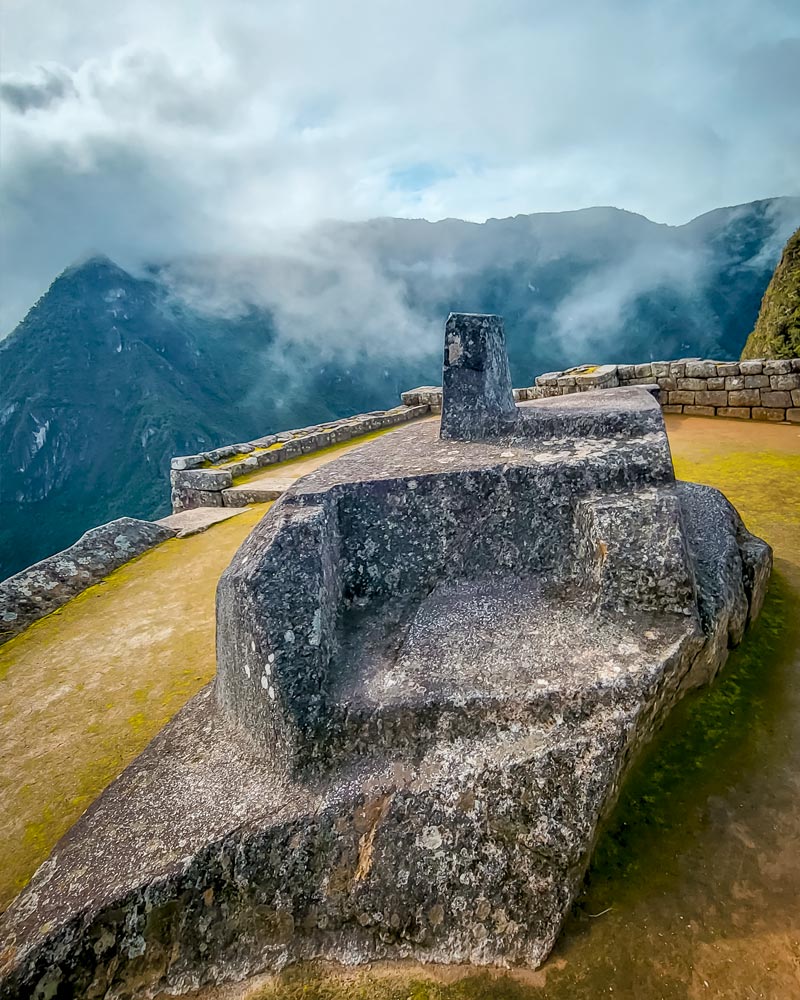
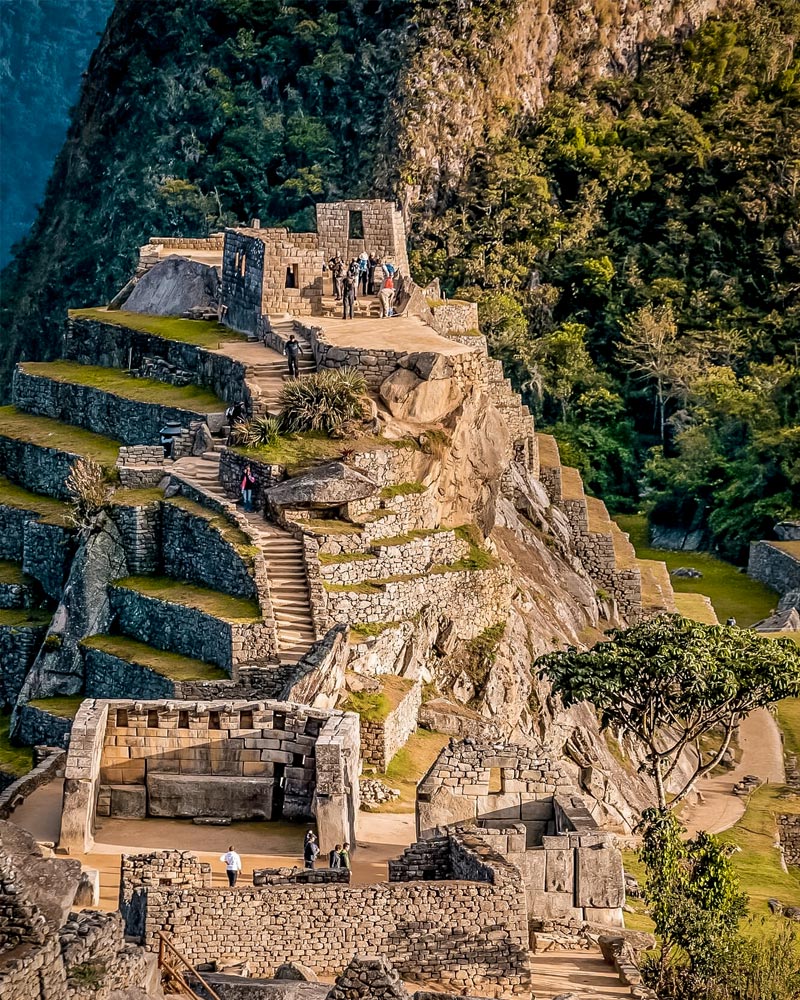
Remember that with Salkantay Trekking, you can reach Machu Picchu safely with expert guides.
Months of the Inca Calendar
| Gregorian Month | Inca Month | Translation |
| January | Huchuy Pacoy | Small harvest |
| February | Hatun Pacoy | Great harvest |
| March | Pawqar Waraq | Flower bouquet |
| April | Ayriwa | Dance of young corn |
| May | Aymuray | Harvest song |
| June | Inti Raymi | Festival of the Sun |
| July | Anta Situwa | Earthly purification |
| August | Qapaq Situwa | General purification sacrifice |
| September | Qaya Raymi | Festival of the Queen |
| October | Uma Raymi | Festival of water |
| November | Ayamarqa | Procession of the dead |
| December | Qapaq Raymi | Magnificent festival |
Celebrations of the Inca Calendar
- December (Raymi): The Great Sun Festival, the “Huarachicuy” ceremony.
- January (Camay): Penances and fasts of the Incas.
- February (Jatunpucuy): Month of flowers, with sacrifices and offerings of gold and silver.
- March (Pachapucuy): Month of rains, with animal sacrifices.
- April (Arihuaquis): Ripening of corn and potatoes (main foods of the Inca people).
- May (Jatuncusqui): Harvest month.
- June (Aucaycusqui): Festival in honor of the sun god (Inti Raymi), coinciding with the winter solstice.
- July (Chaguahuarquis): Month for distributing lands and preparing for sowing.
- August (Yapaquis): Month of planting.
- September (Coyaraymi): Festival in honor of the Coya (queen) to expel evil spirits and diseases.
- October (Humaraymi): Time to invoke rain.
- November (Ayamarca): Time to honor the dead.
Inca Astronomical Observatories
The Incas built some of the most important astronomical observatories in the world. Typically located in temples across their vast empire, they left legacies such as the Machu Picchu and Huayna Picchu mountains, the Intihuatana at Machu Picchu, the Intihuatana at Pisac, and the recently discovered astronomical observatory at Tambo Pampa, in the present-day department of Huánuco.
Thanks to their privileged location, always atop mountains, the Incas enjoyed an outstanding and expansive view of the sky and everything in it. Best of all, they were always “closer” to their main gods: the sun, the moon, the stars, and the mountains.
What is the relationship between Inca astronomy and agriculture?
The Inca civilization was highly organized, and astronomy was essential in determining their agricultural and ritual activities, just as other ancient Peruvian civilizations preceded them. Due to their connection with nature, they understood the sky and its agricultural cycles perfectly. It’s important to remember that Inca agriculture has been the primary foundation of Andean culture from its origins to the present day.
Thanks to astronomical observation (predicting rains and droughts), the Incas developed a critical planting and harvesting system responsible for supplying the entire empire. The main crops obtained included potatoes, mashua, oca, olluco, maize, sweet potatoes, beans, quinoa, and more.
The Incas conducted practical research on solar movements to better organize planting and harvesting periods. The Inca calendar was based on agriculture, with days divided according to the sun and moon’s observation, and each month corresponded to planting, harvesting, or other agricultural activities. For example, every winter solstice (when the sun is furthest from the earth) marked the time for the Incas to celebrate their most fantastic religious festival, Inti Raymi (the Festival of the Sun).
Close your eyes and dream of the stars…
Spending a night at the Sky Camp is an unimaginable experience in the Andes—a gateway to a past filled with mysticism, science, and a connection to the universe. Every constellation, every shadow in the Milky Way, and every corner of the night sky tells stories that have transcended generations, leaving a legacy of wisdom in the mountains.
At the end of this adventure, you’ll have seen the Incas’ sky and felt the magic of ancient knowledge that still lives in every detail of these sacred lands. From the comfort of your glass dome, surrounded by the majesty of Salkantay and Humantay, you’ll carry an unforgettable experience with you—and, hopefully, a new perspective on the sky and its mysteries.
Are you ready for this timeless connection under the stars? Come and experience the magic of the Sky Camp with Salkantay Trekking, where history and the stars come together to share their secrets.


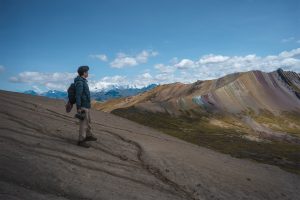
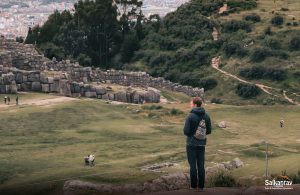
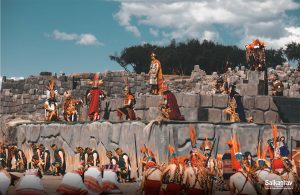

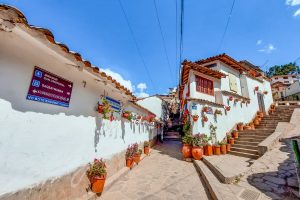


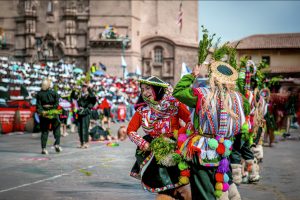
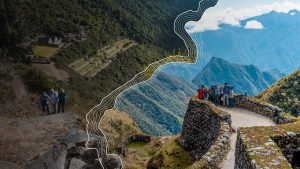
Leave A Reply